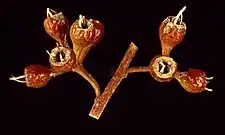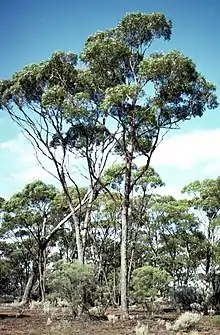Eucalyptus longicornis
Eucalyptus longicornis, commonly known as red morrel,[2] morryl, poot or pu, is a species of large tree that is endemic to the south-west of Western Australia. It has rough, fibrous, fissured bark on the trunk, smooth greyish bark above, flower buds in groups of seven or more, white flowers and shortened spherical fruit.


| Red morrel | |
|---|---|
 | |
| Eucalyptus longicornis near Southern Cross | |
| Scientific classification | |
| Kingdom: | Plantae |
| Clade: | Tracheophytes |
| Clade: | Angiosperms |
| Clade: | Eudicots |
| Clade: | Rosids |
| Order: | Myrtales |
| Family: | Myrtaceae |
| Genus: | Eucalyptus |
| Species: | E. longicornis |
| Binomial name | |
| Eucalyptus longicornis | |
| Synonyms[1] | |
| |
Description
Eucalyptus longicornis is a tree that typically that grows to a height of 2 to 24 metres (7 to 79 ft) and can reach as high as 30 m (98 ft). It has rough, grey brown, fibrous, often fissured bark on the trunk, smooth white to greyish bark above. Young plants and coppice regrowth have stems that are glaucous, more or less square in cross-section, and sessile, lance-shaped to egg-shaped leaves that are 20–85 mm (0.79–3.35 in) long and 9–26 mm (0.35–1.02 in) wide. Adult leaves are arranged alternately, thick, the same shade of glossy green on both sides, linear to narrow lance-shaped, 60–130 mm (2.4–5.1 in) long and 6–13 mm (0.24–0.51 in) wide, tapering to a petiole 10–15 mm (0.39–0.59 in) long. The flower buds are arranged in groups of between seven and thirteen in leaf axils on an unbranched peduncle 6–13 mm (0.24–0.51 in) long, the individual buds on pedicels 4–9 mm (0.16–0.35 in) long. Mature buds are oval, 9–15 mm (0.35–0.59 in) long and 3–6 mm (0.12–0.24 in) wide with a pointed operculum 7–10 mm (0.28–0.39 in) long. Flowering occurs between December and February and the flowers are white. The fruit is a woody shortened spherical capsule 6–8 mm (0.24–0.31 in) long and wide with the valves protruding well above the rim of the fruit. The capsules contain over 200 seeds per gram and persist on the tree until at least the following year, often longer.[2][3][4][5][6]
Taxonomy and naming
_(20718773281).jpg.webp)
This species was first formally described in 1878 by Ferdinand von Mueller who gave it the name Eucalyptus oleosa var. longicornis and published the description in Fragmenta Phytographiae Australiae.[8][9] In 1919 Joseph Maiden noted that Mueller had referred to the species as Eucalyptus longicornis, including in his book Eucalyptographia without having published a description of that species.[10] Maiden published the new name in Journal and Proceedings of the Royal Society of New South Wales, acknowledging Mueller's first use of it.[11]
The Noongar peoples know the tree as morryl, poot or put.[12]
The specific epithet (longicornis) is derived from the Latin words longus meaning "long" and cornu meaning "horn", referring to the shape of the flower buds.
Distribution
The red morrel is distributed through the Wheatbelt and southern Goldfields-Esperance regions of Western Australia.[2] It is found growing in loamy soils, often over limestone or clay loam on flats. The dark red loams, that are rich in minerals and often slightly saline, associated with the decomposition of the fine-grained dolerite gneiss dykes and outcropping units of the Yilgarn Block best suit the tree.[13]
Ecology
The species is usually found in woodland communities where it is an overstorey tree, in an unmixed stand or with E. salmonophloia and either E. melanoxylon, E. wandoo, E. loxophleba, E. astringens or E. kondininensis. Associated species in the understorey include Sclerolaena diacantha, Lycium australe, Acacia merrallii, Melaleuca pauperiflora and Rhagodia drummondii.[13]
Conservation status
This eucalypt is classified as "not threatened" in Western Australia by the Western Australian Government Department of Parks and Wildlife.[2]
Uses
Eucalyptus longicornis is a tall tree with potential to be cultivated on highly alkaline, saline and clayey soils. It is marketed as an ornamental or windbreak species and is useful for apiculture. The wood was used historically in the mining industry as a source of timber and fuel. The fine-textured, reddish to dark red-brown wood has considerable potential for use in high value furniture and craftwood.[5]
See also
References
- "Eucalyptus longicornis". Australian Plant Census. Retrieved 16 September 2019.
- "Eucalyptus longicornis". FloraBase. Western Australian Government Department of Biodiversity, Conservation and Attractions.
- "Eucalyptus longicornis". Euclid: Centre for Australian National Biodiversity Research. Retrieved 1 June 2020.
- Chippendale, George M. "Eucalyptus longicornis". Australian Biological Resources Study, Department of the Environment and Energy, Canberra. Retrieved 16 September 2019.
- "Factsheet Eucalyptus longicornis". Florabank. Retrieved 3 December 2016.
- Lane-Poole, C. E. (1922). A primer of forestry, with illustrations of the principal forest trees of Western Australia. Perth: F.W. Simpson, government printer. p. 76. doi:10.5962/bhl.title.61019. hdl:2027/uiug.30112041668135.
- Maiden, Joseph (1923). A Critical Revision of the Genus Eucalyptus (Volume 6). Sydney: New South Wales Government Printer. p. Plate 241. Retrieved 16 September 2019.
- "Eucalyptus oleosa var. longicornis". APNI. Retrieved 16 September 2019.
- von Mueller, Ferdinand (1878). Fragmenta phytographiae Australiae. Melbourne: Victorian Government Printer. p. 14.
- von Mueller, Ferdinand (1879–1884). Eucalyptographia. A descriptive atlas of the eucalypts of Australia and the adjoining islands. Melbourne: Victorian Government Printer. Retrieved 16 September 2019.
- "Eucalyptus longicornis". APNI. Retrieved 16 September 2019.
- "Noongar names for plants". kippleonline.net. Archived from the original on 20 November 2016. Retrieved 3 December 2016.
- "Eucalyptus longicornis (red morrel) woodland factsheet". Wheatbelt woodlands. Department of Environment and Conservation. Retrieved 3 December 2016.